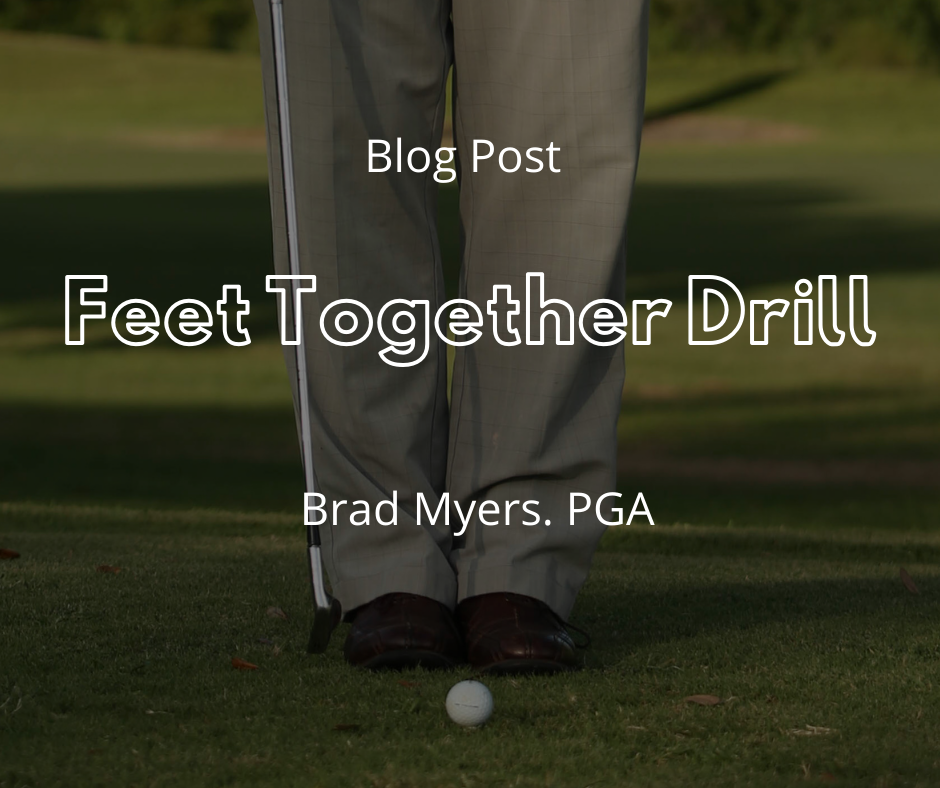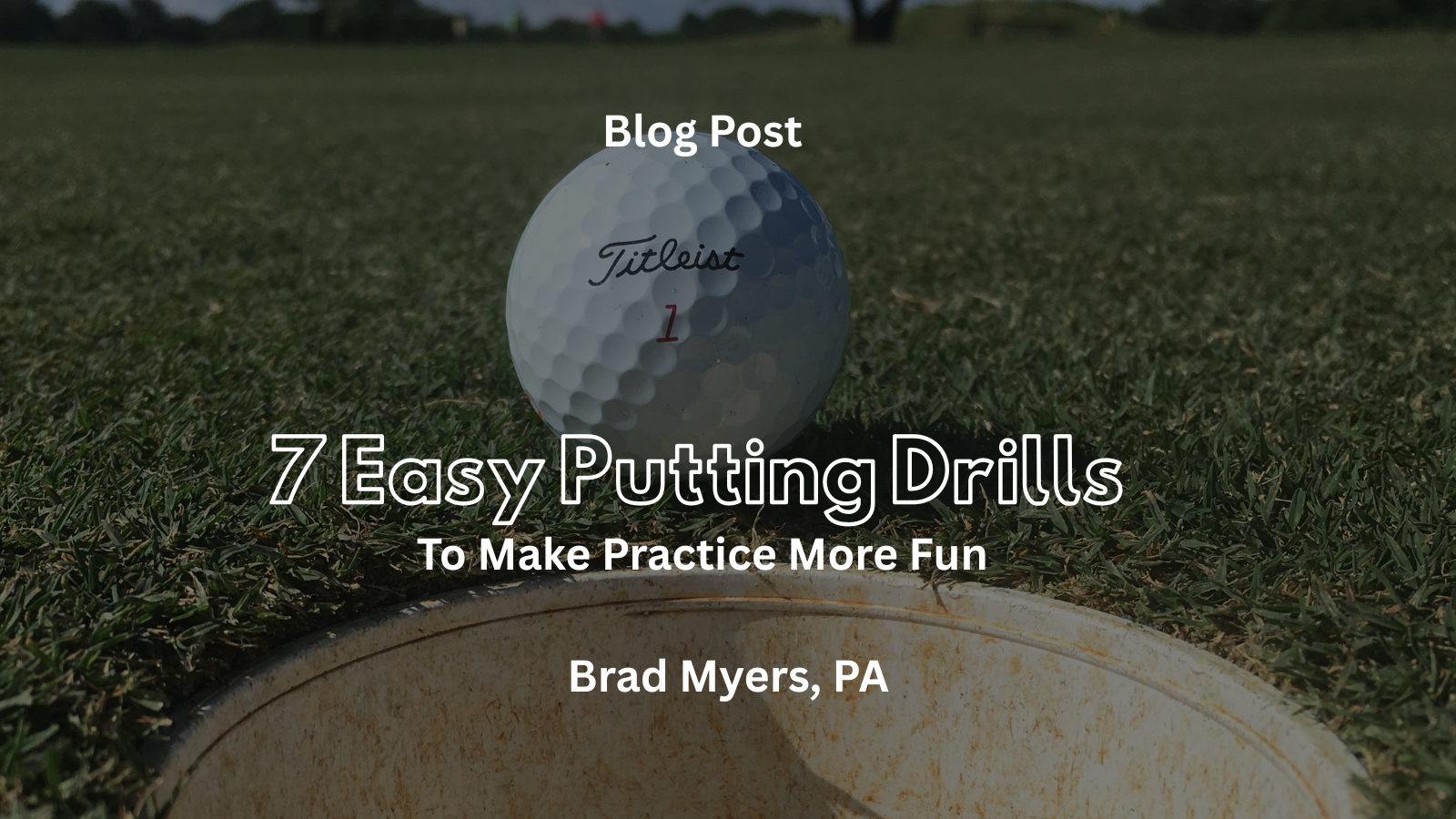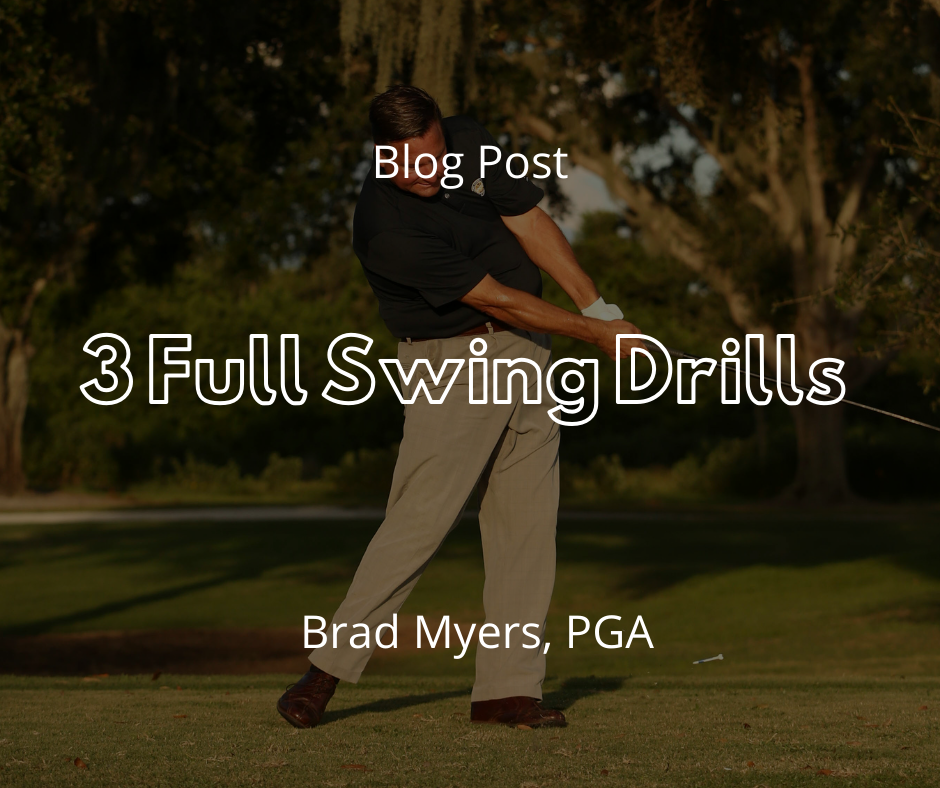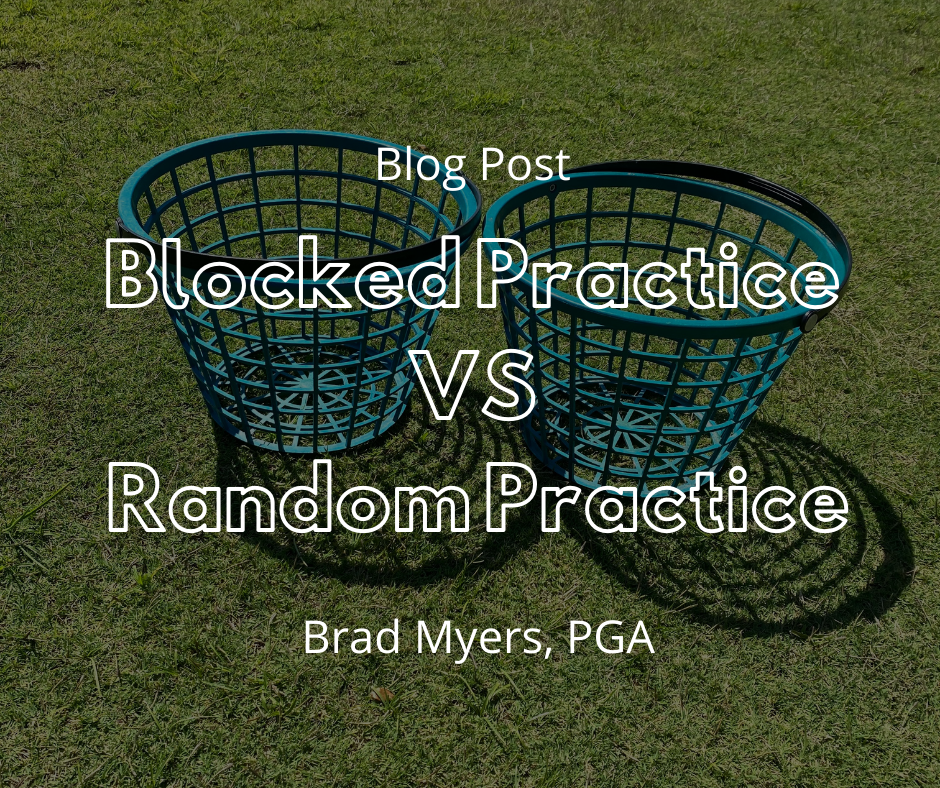As you think back to the article that you read last night and again wonder, “What is blocked practice vs random practice for golfers?”
Another weekend of bad golf and you know something has to change with your practice. You have spent extra time with your golf practice and you are not feeling great about your game as the sun goes down on another day.
It is not only that you are not feeling great about your game… you are downright frustrated with your recent performance, as you feel like you are not learning anything from your practice.
Maybe it is not about doing extra full swing practice drills, short game practice drills or putting practice drills? Could that be true? One thing that most golfers agree on is that just because you hit your driver or irons great on the range that does not guarantee that you will hit them great on the golf course.
Well… not to be harsh… but… what you have been doing to improve your performance through your practice has not been working. What should you do next?
Maybe the answer to improving your performance is just as simple as understanding the difference between block practice and random practice…
What Is Blocked Practice vs Random Practice?
What Is Block Practice For Learning?
A simple explanation of block golf practice is when a player performs a single skill over and over. The key is repeating the skill with no variance in the training practice.
So in a practice setting, the driving range is a constant as you will have a flat lie for every shot. A player gets a full swing drill to improve their performance from their instructor and does the drill with the same club and keeps hitting it to the same target. Again… and again… and again… etc.
In a 2001 study by Simon and Bjork, athletes who were trained using blocked practice were more likely to predict higher levels of future task performance than those who were trained using random practice designs.
So… This must be the best way for you to practice… right?
Well… If a player’s practice drills enable them to quickly improve performance, it is human nature to think that they are improving, making progress or actually learning something.
However, this leads to a culture of practice or training that is too easy or comfortable for the player. In the future, the player will use types of practice conditions to act as a crutch and ultimate learning will not take place.
Unfortunately, the inverse is true as well. We think that if completing the task is difficult then we are not learning. This is not necessarily true.
It has been proven in multiple studies that blocked practice can give you a false sense of learning.
During a blocked practice session, a player or a coach can get to where they “see improvement” or improve performance but, when the target or clubs are changed the player cannot then perform the skill.
Even if the player can perform with the variable(s) or improve their current performance, true learning has not taken place until the player can perform the skill at a later time.
This is when you are frustrated on Sunday Evening from not meeting your expectations from your practice sessions earlier in the week, because your game did not go from the practice range to the course with you.
Although one of the newer buzz-words or phrases in the golf performance coaching world is random practice, blocked practice is an important part of learning when first learning a new skill.
You cannot simply forget blocked practice and not take the time to do it in your practice sessions.
Like everything else in golf (it seems), there are many factors or variables that go into acquiring a new skill. All players bring some skill level with them from other activities that they have done.
What A Blocked Session Should Look Like
If you have spent any time at all on a driving range, you have seen blocked practice. You may or may not have known that it was blocked practice but, trust me… You have seen some major blocked practice by juniors and adults. haha
A player walks out onto the driving range and pulls out their driver to practice. They then stay in the exact same spot and swing at the exact same target attempting to create the same swing over and over again FOR THE ENTIRE PRACTICE SESSION.
Many of these players are trying to “get a feeling” or change their actual swing. They are trying to acquire a certain position in the backswing with their driver or iron.
When you are on the practice tee, you will notice this activity more now as they are the golfers that will take a slow practice swing, stop at the top of their swing and then continue back to impact… multiple times.
The focus of blocked practice is to do the same thing over and over without changing any variables. Some players achieve this type of practice by using training aids that keep their bodies in certain positions throughout a motion.
This is a needed part of your regular practice but may not be how it works on the course for you.
What Is Random Practice?
A simple explanation of random practice is when a player performs a skill and a variable or variables change(s) with each swing.
The practice variables include but are not limited to the club being used, trajectories, distances, training aids, shot shapes and your lie.
The results of the Shea and Morgan experiment surprised many scientists in the field by showing that, even though random conditions result in much less skilled performance than blocked conditions in acquisition, random-practice conditions produce more learning. This became truer when retention tests were given at later times.
Current thoughts on benefits of learning with random practice include:
- Random practice forces the learner to become more actively engaged in the learning process by preventing simple repetitions of actions.
- Random practice gives the learner more meaningful and distinguishable memories of the various tasks, increasing memory strength and decreasing confusion among tasks.
- Random practice causes the learner to forget the short-term solutions (from working memory) to the movement problem after each task change.
- Forgetting the short-term solution in random practice, forces the learner to generate the solution again on the task’s next trial, which is beneficial to learning.
A Random Session To Improve Performance
I can hear you now… “Great! So… What does this mean random practice should look like?”
It means that when in random practice, every shot should have a different variable(s) happening.
Example 1 – Many players will “play the course” for random practice. They will swing the club that they would choose off of each teeing ground. They then take the club that they would expect to swing into the green and continue “around the course.”
Example 2 – If you have been stuck in block practice using a training aid, hit a ball using full training aid setup but swing slow and hit the shot only three-quarters of the usual distance.
On the second swing, use the full training aid set up and hit it a full distance for you.
On the third attempt, make a full swing with no training aid.
Example 3 – One of my favorite ways to have my students practice is to take a three wood, six iron and pitching wedge out of their bag and make swings without hitting the same club twice in a row.
In addition, do not just go up and down the ladder meaning do not keep using the same order. Make this very random.
For a better player’s practice, I may add not hitting the same trajectory or shape twice in a row.
Example 4 – Take eight practice balls to the chipping/pitching green. Pick a hole on the green and place four balls off the green in a line two big steps apart going away from the hole.
Take the other four balls and do the same thing two or three big steps to the right or left of the original balls. You should have some railroad tracks.
Now pick a club and play a shot to all eight of the holes. Once completed, do it again with a different club. Figure out with the loft on your club how you are going to get it close to the hole.
Example 5 – For putting practice, take three balls to the putting green. Place a tee in an empty part of the putting green.
Stroke putts so that one ball stops short of the tee, one stops at the tee and one ball rolls just past the tee.
So… If you feel like you are spending the time to improve and are not seeing the results, maybe you need to look at how you are practicing, quantify if learning is taking place and not just repeating the same old sessions.
With where you are in the learning process, blocked practice vs. random practice will help you determine your best plan of attack to improve your game on the course.
I would love to hear about how you are going to change your practice to improve your learning. Send me your practice details in an email at coach@ballflightacademy.com.
What Are Other Golfers Saying?
EXCELLENTTrustindex verifies that the original source of the review is Google. I recently had the privilege of receiving golf instruction from Brad after years of inconsistent golf play. His ability to break down complex concepts into simple, digestible instructions is a testament to his skills as a golf instructor. Brad creates a relaxed and positive learning environment, making it easy to ask questions and seek clarification. Whether you're a beginner or an experienced golfer, Brad has the ability to identify and correct the subtle flaws in your technique, leading to improvements in your overall game. He is professional, courteous and a true asset to anyone seeking to enhance their golfing skills. Thanks to Brad, my golf game is much more enjoyable!Trustindex verifies that the original source of the review is Google. I am a new golfer and just started playing 2 years ago with my roommates in college. Now that I have graduated, I’ve wanted to play the game more seriously and started taking lessons 3 months ago. I have had multiple instructors with little improvement. Brad was the first instructor that was able to break down my swing in the simplest way and gave me a better understanding of how my body is supposed to move through my swing. Brad is articulate and concise which is great for me as a beginner golfer because he is able to efficiently communicate without confusion or over-explanation. I have seen more improvement from my one session with him than I have with any other instructor. 1 week on from my lesson with him I am making much better contact with the ball and my swing is smoother and straighter. Thank you Brad, I look forward to taking another lesson from you!Trustindex verifies that the original source of the review is Google. Brad is one of the best golf instructors I’ve had. He’s very patient, and worked with my swing. It was horrible in the beginning. He broke it down and explained, in small steps, how to improve it. I was never overwhelmed. He gave me drills to do, and I followed his instructions. After 8 lessons, my game has improved immensely. Brad met me at a club fitter, which was helpful. I plan to take more lessons as soon as my rotator cuff is healed! (Not from golf)Trustindex verifies that the original source of the review is Google. WOW, what a great training experience. Brad is patient, knowledgeable and a great instructor. He is able to feed information in small increments and it makes it so much easier to learn. I am looking forward to more lessons on the future.Trustindex verifies that the original source of the review is Google. I am new to the area so I was looking for a golf coach who could help me improve my game. I have played golf for 35 years but as I have aged, I needed to adjust my swing with golf lessons and expert instruction. I found Brad's website with a plethora of options including private and group lessons. In the last 3 weeks with Brad's coaching, I have enrolled in both private and group instruction with substantial Improvement. Besides being an amazing coach, Brad has exceptional interpersonal skills. He is authentic and truly wants to learn about you and your golf game. He has the latest technology and is able to explain the results which translates to a better golf game. Thank you Brad! I appreciate all of your help, patience, and guidance.Trustindex verifies that the original source of the review is Google. I started taking lessons in July 2022 and my goal was to regain my swing that I had lost due to lack of play for 10 years. I was shooting 100-105. My goal was to regain my tempo and break 90 by 1/1/23. That goal was shattered in just 90 days. I’m now scoring in the mid 80’s consistently and I’ve shot 79 once. Brad has been there every step of the way. He breaks the swing down in bite size pieces. I improve after each lesson and he’s there for his students daily. He even helped me get fit with a custom driver just a few weeks ago at Club Champion. He’s the real deal if you want to improve your game. Thanks BradTrustindex verifies that the original source of the review is Google. Brad is a great Golf Instructor. He is good at asking questions to help you learn rather than just giving you the answer right away. Helped me fix my swing and find consistency. Responds to texts when I have questions during practice to keep me moving in the right direction. Highly recommend.Trustindex verifies that the original source of the review is Google. After so much frustration hacking away at balls on the range - it was a relief to finally have fun. I improved more in my one hour with Brad than I have in the past two months getting back into the game. His style is personable and relaxed, and he is a very effective communicator explaining concepts and correct feels. I finally feel confident standing over a golf ball again, and look forward to my next lesson with Brad. Roll Tide!Trustindex verifies that the original source of the review is Google. Really personable, easy to get a long with, and great applicable knowledge. I was a little anxious because I have a non traditional swing, but I was at ease with Brad immediately. He didn’t try and change my swing, rather he showed me where I could improve using my normal swing. I highly recommend Brad to anyone looking to improve their game.Trustindex verifies that the original source of the review is Google. Brad is an extremely knowledgeable and patient instructor. He explains things in an easy to follow manner. I highly recommend.
Change Your Golf Swing With The Articles Below...

Feet Together Drill For Golf
Can improving your golf swing be as easy as using the feet together drill? The answer is, Yes! Can golf instruction really be that easy?.. “90 percent of players would be better playing with their feet together. Why? Because they will

7 Easy Putting Drills To Lower Your Scores In Your Next Round
Although players are always looking for the best putting drills to solve all of their putting woes, there is more to making more putts than just having a good putting stroke. There are three facets that all good or great

3 Uncomplicated Full Golf Swing Drills That WILL Improve Your Game
Implementing full swing drills into your practice routine is still a vital part of creating a functional golf swing. Currently, one of the buzzwords in the teaching industry is to use random practice to improve your golf swing. However, it

Hitting Driver Basics: Why Is The Driver So Hard To Hit?
How many times during a round of golf do you stand and ask, “What are some of the hitting driver basics?” If you are currently struggling with the driver, you will probably not agree with me … but… Your driver
GRAA Top !00 Golf Instructor in the US at The Ball Flight Academy
Brad Myers, PGA started The Ball Flight Academy to further assist his players to reach their golfing goals no matter if they are taking private golf lessons or online golf lessons.
After graduating from New Mexico State University with a degree in Professional Golf Management, Brad has taught at top golf facilities in the United States including the TPC at Sawgrass, Alabama’s Robert Trent Jones Golf Trail, The Woodlands Country Club, and Resort as well as the TPC at The Woodlands.
Brad Myers is currently a golf coach in Sarasota - Bradenton, Florida, and holds multiple certifications from…
- PGA of America in Teaching and Coaching.
- Trackman – Level 2
- Swing Catalyst – Level 2
- Titleist Performance Institute (TPI) – Level 1
- US Kids – Certified Golf Coach
In addition, Brad Myers, PGA is an Amazon Best Selling Author with his first book Golf Shots and Unicorns – Set Up Basics.
- Virtual Golf Lessons - February 9, 2025
- Winter Golf Training: If You Must Go Indoors… - October 1, 2024
- 3 Day Golf School - June 4, 2023

